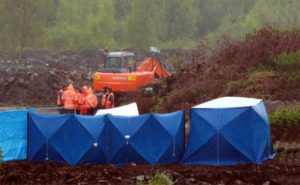Le ricerche stanno continuando nelle Contee di Monaghan, Meath e Louth, nel tentativo di recuperare i corpi dei cosiddetti “Disappeared”

Il resti sono stati rimossi e portati a Dublino per gli esami.
Si ritiene appartengano a Charlie Armstrong, 54 anni, svanito nell’agosto del 1981 . Sarebbe stato assassinato dai Provisional IRA.
Armstrong, padre di 5 figli, scomparve mentre si recava a messa nella cittadina di Crossmaglen.
Non è mai stata data una spiegazione sul suo omicidio.
L’area è ancora cordonata e la Garda la sta gestendo come una scena del crimine.
L’augurio è che le condizioni relativamente buone dei resti recuperati faciliterà il processo di identificazione.
Operazioni di ricerca
L’IRA ammise nel 1999 di aver ucciso e sepolto in luoghi segreti nove dei Disappeared (gli Scomparsi): Seamus Wright, Kevin McKee, Jean McConville, Columba McVeigh, Brendan Megraw, John McClory, Brian McKinney, Eamon Molloy e Danny McElhone.
I corpi di Molloy, McKinney, McClory, McConville e McElhone sono stati ritrovati.
Le altre persone scomparse senza lasciare traccia durante i Troubles comprendono Gerry Evans, Robert Nairac e Seamus Ruddy, scomparso in Francia e la cui morte è stata rivendicata dall’INLA.
L’ICLVR fu istituita dai governi inglese ed irlandese nel 1999 e invia i rapporti al Northern Ireland Office a Belfast e al Ministero della giustizia irlandese a Dublino.
Nel 2007 ha portato Geoff Knupfer, lo scienziato investigativo che ha aiutato nel ritrovamento dei corpi delle vittime dei Moors Murderers Ian Brady e Myra Hindley, a dare un nuovo approccio scientifico alle ricerche.
Questo ha portato alla creazione di una squadra archeologica, costituito da geofisici che utilizzano radar, scanner, sonde e cani adatti a cercare resti umani.
Tratto da Rté
Searches continue for the ‘Disappeared’
Searches are continuing in counties Monaghan, Meath and Louth to try to recover the bodies of more of the so-called ‘Disappeared’.
The remains will be removed today and brought to Dublin for examination.
It is believed they are those of 54-year-old Charlie Armstrong who vanished in August 1981 and is believed to have been murdered by the Provisional IRA.
Mr Armstrong, a father-of-five, disappeared while on his way to mass in Crossmaglen 29 years ago.
No reason has ever been given as to why he was murdered.
The area is still sealed-off as gardaí are treating it as a murder scene.
It is hoped the relatively good condition of the remains will ease the process of identification.
Search operation
The IRA admitted in 1999 that it killed and buried nine of the disappeared – Seamus Wright, Kevin McKee, Jean McConville, Columba McVeigh, Brendan Megraw, John McClory, Brian McKinney, Eamon Molloy and Danny McElhone – in secret locations.
The bodies of Mr Molloy, Mr McKinney, Mr McClory, Ms McConville and Mr McElhone have been found.
Others who vanished during the Troubles include Gerry Evans, Robert Nairac and Seamus Ruddy, who disappeared in France and whose murder was admitted by the INLA.
The ICLVR was set up by the British and Irish Governments in 1999 and reports to the Northern Ireland Office in Belfast and the Irish Justice Department in Dublin.
In 2007, it brought in Geoff Knupfer, the investigative scientist who helped find the bodies of the victims of Moors Murderers Ian Brady and Myra Hindley, to spearhead a new scientific approach to the searches.
This included bringing in an archaeological ‘time-team’, made up of geophysicists who used ground radar, scanners, probes and cadaver dogs which detect human remains.